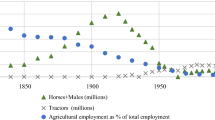Abstract
The absence of available credit to finance reforestation investments among NIPF landowners has been one of the contributing reasons why landowners do not reforest after harvest. Financial assistance programs are therefore a solution to initiating reforestation investments. However, previous studies indicate many landowners are not actively participating in existing government assistance programs. This paper examines reforestation loans as an alternative financial assistance program. Landowner participation in a proposed reforestation loan program is modeled using logistic regression. Results indicate that landowner participation in the program is influenced by ownership size, socio-demographic characteristics, and availability of other forestry incentive and assistance programs.
Similar content being viewed by others
References
Beach, R.H., Pattanayak, S.K., Yang, J., Murray, B.C. and Abt, R.C. (2002), ‘Empirical studies of non-industrial private forest management: a review and synthesis’, Working Paper 02_05, Research Triangle Institute, www.rt.org/pubs/rtipaper_02_05.pdf, cccessed 23 July 2003.
Bell, C.D., Roberts, R.K., English, B.C. and Park, W.M. (1994), ‘A logistic analysis of participation in Tennessee’s forest stewardship program’, Journal of Agricultural and Applied Economics, 26 (2), 463–472.
Ben-Akiva, M.E. and Lerman, S.R. (1985), Discrete Choice Analysis: Theory and Application to Travel Demand, MIT Press, Cambridge.
Bliss, J.C. and Martin, F.A. (1989), ‘Identifying NIPF management motivations with qualitative methods’, Forest Science, 35 (2), 601–622.
Bullard, S.H. and Straka, T.J. (1988), ‘Structure and funding of state-level forestry cost-share programs’, Northern Journal of Applied Forestry, 5 (2), 132–135.
Dillman, D.A. (1978), Mail and Telephone Surveys — The Total Design Method, John Wiley, New York.
Doolittle, M.L. (1996), An inventory of private landowners in Mississippi, Social Science Research Center, Mississippi Agricultural and Forestry Experiment Station, Mississippi State University, Mississippi.
Esseks, J.D. and Kraft, S.E. (1988), ‘Why eligible landowners did not participate in the first four sign-ups of the conservation reserve program’, Journal of Soil and Water Conservation, 43 (3), 251–255.
Esseks, J.D. and Kraft, S.E. (1989), ‘Marketing the conservation reserve program’, Journal of Soil and Water Conservation, 44 (5), 425–430.
Esseks, J.D. and Moulton, R.J. (2000), Evaluating the forest stewardship program through a national survey of participating forest landowners, The Center for Governmental Studies, Social Science Research Institute, DeKalb, IL: Northern Illinois University.
Greene, J.L. and Blatner, K.A. (1986), ‘Identifying woodland owner characteristics associated with timber management’, Forest Science, 32 (1), 135–146.
Greene, W.H. (1995), LIMDEP Version 7.0 — User’s Manual and Reference Guide, Econometric Software Inc., New York.
Gunter, J.E., Idassi, J. and Granskog, J.E. (2001a), Financing investments in reforestation with government-sponsored loans: a Mississippi case study, Forest and Wildlife Research Center Bulletin FO194, Mississippi State University, Mississippi.
Gunter, J.E., Bullard, S.H., Doolittle, M.L. and Arano, K.G. (2001b), Reforestation of harvested timberlands in Mississippi: behavior and attitudes of nonindustrial, private forest landowners, Forest and Wildlife Research Center Bulletin FO172, Mississippi State University, Mississippi.
Jamnick, M.S. and Beckett, D.R. (1987), ‘A logit analysis of private woodlot owner’s harvesting decisions in New Brunswick’, Canadian Journal of Forest Research, 18 (1), 330–336.
Lorenzo, A.B. and Beard, P. (1996), ‘Factors affecting the decisions of NIPF owners to use assistance programs’, in M.J. Baughman (ed.), Proceedings of the Symposium on Nonindustrial Private Forests: Learning From Past, Prospects for Future, University of Minnesota, St. Paul, Minnesota: pp. 264–275.
Manski, C. (1977), ‘The structure of random utility models’, Theory and Decision, (8), pp. 229–254.
Mills, W.L. Jr., Hoover, W.L., Vasan, S., McNamara, K.T. and Nagubadi, V. (1996), ‘Factors influencing participation in public management assistance programs’, in M.J. Baughman (ed.), Proceedings of the Symposium on Nonindustrial Private Forests: Learning From Past, Prospects for Future, University of Minnesota, St. Paul, pp. 204–213.
Nodine, S.K. (1993), ‘Reforestation delay tolerance under the Forestry Incentive Programs’, Canadian Journal of Forest Research, 23 (3), 414–426.
Performance Evaluation and Expenditure Review (PEER) Committee. (1998), ‘A policy framework for evaluating options for further encouraging Mississippi’s nonindustrial private owners of forestland to reforest’, Report 374, http://www.peer.state.ms.us/374.html, accessed 22 July 2003.
Provencher, B. (1990), ‘A new approach to increasing timber supply from the non-industrial private forests of the South’, Land Economics, 66 (1), 102–106.
Pyndick, R.S. and Rubinfeld, D.L. (1981), Econometric Models and Economic Forecasts, 2nd Edn, McGraw-Hill, New York.
Romm, J., Tuazon, R. and Washburn, C. (1987), ‘Relating forestry investment to the characteristics of non-industrial private forestland owners in Northern California’, Forest Science, 33 (1), 197–209.
Royer, J.P. and Moulton, R.J. (1987), ‘Reforestation incentives: tax incentives and cost-sharing in the South’, Journal of Forestry, 85 (8), 45–47.
Stevens, T.H., Dennis, D., Kittredge, D. and Rickenbach, M. (1999), ‘Attitudes and preferences toward co-operative agreements for management of private forestlands in the north-eastern United States’, Journal of Environmental Management, 55 (2), 81–90.
Sullivan, J., Amacher, G.S. and Chapman, S. (2002), ‘Forest banking in theory and practice: empirical results from Virginia’, in G.S. Amacher and J. Sullivan (eds.), Proceedings of the 2002 Southern Forest Economics Workshop, Virginia Polytechnic Institute and State University, Blacksburg, VA, pp. 295–304.
Webster, H.H. and Stoltenberg, C.H. (1959), ‘What ownership characteristics are useful in predicting response to forestry programs?’, Land Economics, 35 (3), 292–295.
Author information
Authors and Affiliations
Rights and permissions
About this article
Cite this article
Arano, K.G., Munn, I.A., Gunter, J.E. et al. Modeling landowner participation in a proposed reforestation loan program. Small-scale Forestry 3, 177–190 (2004). https://doi.org/10.1007/s11842-004-0013-2
Issue Date:
DOI: https://doi.org/10.1007/s11842-004-0013-2




